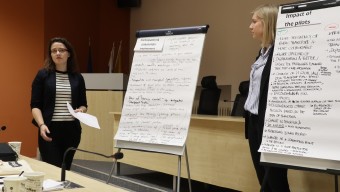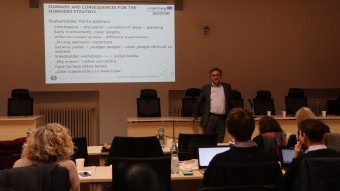SubNodes:
6th Partner meeting
19-20 February 2020, Bratislava, Slovakia
At the sixth partner meeting, the partners meet to reflect on the ‘Subnodes Strategy’ and review their validity in the light of the experiences made. Following the meeting, the strategy was updated according to the assessment conclusions.
Below you find a summary of the project partnership's conclusions.
The Subnodes Strategy was compiled as the basis for the SubNodes project. At the end of the project and after the implementation of this approach in selected regions, the validity of the strategy had to be proven.
The Subnodes Strategy follows the approach to promote a polycentric development in the public transport sector and to improve the peri-urban and hinterland accessibility by the development of so-called ‘subnodes’ - intermodal secondary hubs. Therefore, three main objectives were combined for this implementation. Partially these objectives could be achieved. All pilot actions have contributed to strengthening the cities as subnodes. Furthermore, the concept of subnodes proved successful and is transferable to other regions. The pilot actions have partially contributed to making intermodal and public traveling more attractive and raised political awareness. Moreover, collaboration and cooperation have been improved through the project and encouraged decision-makers for the next steps for the sustainability of the process. Also, the regions and actors gained more experience and knowledge on a scope of transport that is by far less in the focus of public and scientific attention than e.g. inner-urban or inter-city transport.
However, because of the short project period and implementation of the pilot actions there is little reliable data about new passengers or to identify changes in modal split. The implementation of a subnode and such measures takes time and is a long-term and dynamic process. As a result, key elements and objectives can change and should be proved after a certain time after implementation. The same can be emphasized for the validation of the hypotheses of the strategy. The pilot actions were limited and too short to verify or falsify them with data and concrete information.
Through the SubNodes project stakeholder involvement and participation gained more importance and should be added to the process of the implementation of a subnode. Therefore, target groups and the format of participation should be clear at the beginning. Nevertheless, (mutual) learning from ‘SubNodes’ works out: pilot actions and measures are good practices for their regions and for other regions.
After the completion of the project, the idea and approach of subnodes could be continued. One suggestion is extending the approach by other facilities and services, e.g. institutions for social infrastructure, local suppliers or working spaces. Especially for rural areas, it could be a possibility to ensure the general supply and to reduce regional disparities. Besides, this extension of the functions of a subnode could strengthen the importance in the region.
Moreover, it is advisable to develop ‘sub-subnodes’ in the rural hinterland to better connect them to subnodes and thereby continue the hierarchical principle because the present ‘subnodes’ (mid-sized cities) have a relatively large scale and mostly more than 20 000 inhabitants. It is conceivable to analyse and follow the approach of ‘sub-subnodes’ in future projects.

